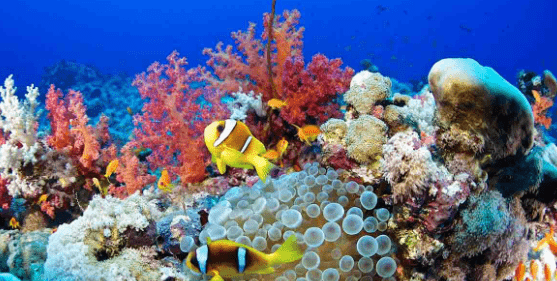By Islam Salah
The Middle East is home to some of the world’s most diverse and vibrant marine ecosystems. With its proximity to warm tropical waters and unique geographical features, the area boasts a stunning variety of marine life.
However, the fragile balance of these ecosystems is increasingly under threat, making preserving marine biodiversity in the region more crucial than ever.
From the tranquil waters of the Arabian Gulf to the thriving coral reefs of the Red Sea, these marine environments not only support an incredible array of species but also play a vital role in sustaining coastal communities and economies.
Let’s explore what makes this biodiversity unique, the challenges it faces, and the efforts to protect it!
Unique Marine Species in the Middle East
The Middle East is home to several iconic marine species that are vital to its ecosystems. Some of the most notable examples include:
- Dugongs: Often called “sea cows,” these gentle herbivores are found in the Persian Gulf, specifically around Qatar, where they play a key role in maintaining healthy seagrass beds essential for reducing carbon emissions.
- Sea Turtles: Endangered species like the hawksbill and green turtle nest along the region’s beaches in the Gulf and Egypt, contributing to the coastal ecosystem’s health.
- Coral Species: The Red Sea is home to some of the world’s most resilient coral reefs, supporting diverse marine life.
- Fish Populations: Species such as clownfish, groupers, and barracudas thrive in the region, maintaining balance within marine food webs.
- Marine Mammals: Dolphins and other marine mammals also inhabit these waters, adding to the region’s ecological richness.
Threats to Marine Biodiversity
Despite the richness of marine life, the Middle East faces several significant threats that put its biodiversity at risk.
- Overfishing: One of the leading concerns, with unsustainable fishing practices depleting fish stocks and damaging delicate marine ecosystems.
- Pollution: Particularly plastic waste and oil spills, have wreaked havoc on marine life, with marine animals ingesting or becoming entangled in debris.
- Climate Change: A growing threat causing coral bleaching and rising sea temperatures that impact species’ survival.
- Habitat Destruction: Coastal development and dredging further exacerbate the situation, disrupting the delicate balance of these ecosystems.
Conservation Efforts
In response to these challenges, several conservation initiatives are underway across the region. Marine protected areas (MPAs) have been established in key locations to safeguard coral reefs and other critical habitats.
For example, the Red Sea’s coral reefs benefit from protection through national and international efforts, including collaboration with UNESCO’s Biosphere Reserves.
Plus, organizations such as the Emirates Wildlife Society are leading efforts to reduce plastic pollution and promote sustainable fishing practices. Local initiatives also work on rehabilitating endangered species like sea turtles and dugongs!
Marine Biodiversity Hotspots: Arabian Gulf and Red Sea
The Arabian Gulf and Red Sea are among the most biodiverse marine areas in the world. The Arabian Gulf is known for its warm waters, which host vibrant fish species, while the Red Sea is famous for its deep-blue waters and thriving coral ecosystems.
Key spots to visit include the coral-rich areas around Bahrain, the UAE’s marine reserves, and the pristine dive sites along Egypt’s Sinai Peninsula. These locations offer a glimpse into the extraordinary marine life the region has to offer.
Protecting a Natural Treasure
The marine ecosystems of the Middle East are truly one-of-a-kind, but they need protection. With continued conservation efforts, sustainable practices, and global collaboration, there is hope for preserving these natural wonders. It’s up to all of us to raise awareness and support the efforts that protect the biodiversity of this vital region!
WE ALSO SAID: Don’t Miss…Exploring Marine Life: 5 Of The Best Aquariums In The Middle East



